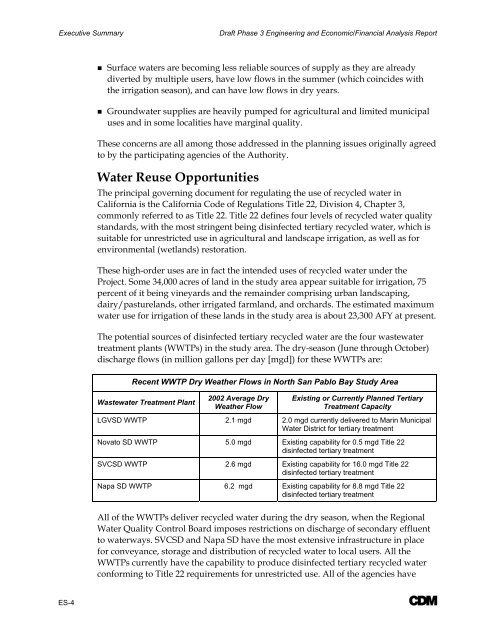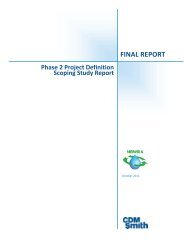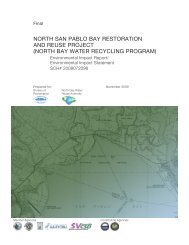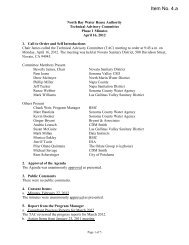Phase 3 Feasibility Report (Table of Contents & Executive Summary)
Phase 3 Feasibility Report (Table of Contents & Executive Summary)
Phase 3 Feasibility Report (Table of Contents & Executive Summary)
Create successful ePaper yourself
Turn your PDF publications into a flip-book with our unique Google optimized e-Paper software.
<strong>Executive</strong> <strong>Summary</strong><br />
Draft <strong>Phase</strong> 3 Engineering and Economic/Financial Analysis <strong>Report</strong><br />
• Surface waters are becoming less reliable sources <strong>of</strong> supply as they are already<br />
diverted by multiple users, have low flows in the summer (which coincides with<br />
the irrigation season), and can have low flows in dry years.<br />
• Groundwater supplies are heavily pumped for agricultural and limited municipal<br />
uses and in some localities have marginal quality.<br />
These concerns are all among those addressed in the planning issues originally agreed<br />
to by the participating agencies <strong>of</strong> the Authority.<br />
Water Reuse Opportunities<br />
The principal governing document for regulating the use <strong>of</strong> recycled water in<br />
California is the California Code <strong>of</strong> Regulations Title 22, Division 4, Chapter 3,<br />
commonly referred to as Title 22. Title 22 defines four levels <strong>of</strong> recycled water quality<br />
standards, with the most stringent being disinfected tertiary recycled water, which is<br />
suitable for unrestricted use in agricultural and landscape irrigation, as well as for<br />
environmental (wetlands) restoration.<br />
These high-order uses are in fact the intended uses <strong>of</strong> recycled water under the<br />
Project. Some 34,000 acres <strong>of</strong> land in the study area appear suitable for irrigation, 75<br />
percent <strong>of</strong> it being vineyards and the remainder comprising urban landscaping,<br />
dairy/pasturelands, other irrigated farmland, and orchards. The estimated maximum<br />
water use for irrigation <strong>of</strong> these lands in the study area is about 23,300 AFY at present.<br />
The potential sources <strong>of</strong> disinfected tertiary recycled water are the four wastewater<br />
treatment plants (WWTPs) in the study area. The dry-season (June through October)<br />
discharge flows (in million gallons per day [mgd]) for these WWTPs are:<br />
Recent WWTP Dry Weather Flows in North San Pablo Bay Study Area<br />
Wastewater Treatment Plant<br />
2002 Average Dry<br />
Weather Flow<br />
Existing or Currently Planned Tertiary<br />
Treatment Capacity<br />
LGVSD WWTP 2.1 mgd 2.0 mgd currently delivered to Marin Municipal<br />
Water District for tertiary treatment<br />
Novato SD WWTP 5.0 mgd Existing capability for 0.5 mgd Title 22<br />
disinfected tertiary treatment<br />
SVCSD WWTP 2.6 mgd Existing capability for 16.0 mgd Title 22<br />
disinfected tertiary treatment<br />
Napa SD WWTP 6.2 mgd Existing capability for 8.8 mgd Title 22<br />
disinfected tertiary treatment<br />
All <strong>of</strong> the WWTPs deliver recycled water during the dry season, when the Regional<br />
Water Quality Control Board imposes restrictions on discharge <strong>of</strong> secondary effluent<br />
to waterways. SVCSD and Napa SD have the most extensive infrastructure in place<br />
for conveyance, storage and distribution <strong>of</strong> recycled water to local users. All the<br />
WWTPs currently have the capability to produce disinfected tertiary recycled water<br />
conforming to Title 22 requirements for unrestricted use. All <strong>of</strong> the agencies have<br />
ES-4<br />
A








